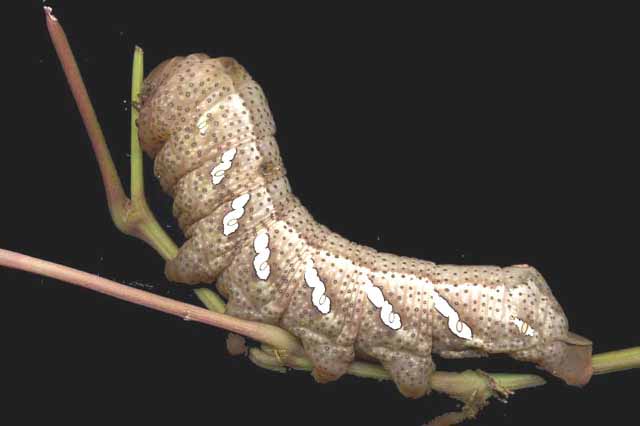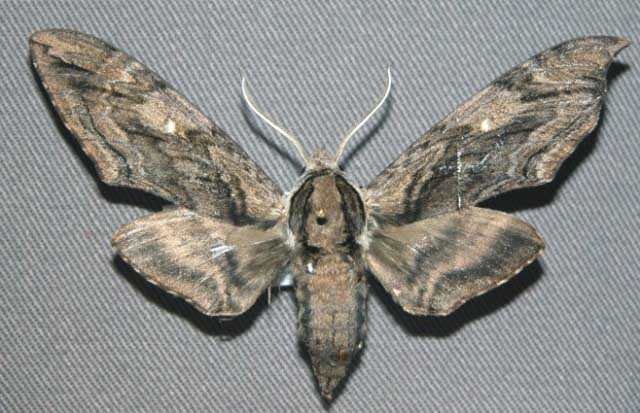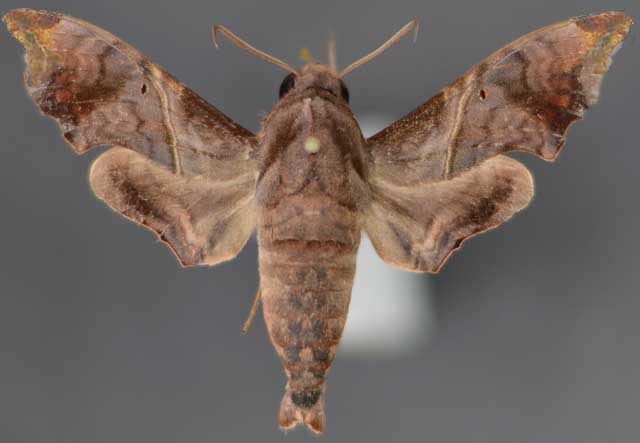Sphinginae subfamily
Sphingini tribe:
 |
Agrius cingulata,
TM Pink-spotted hawkmoth,
fall stray
This species is a strong migrant and adults nectar from
deep-throated flowers including moonflower (Calonyction aculeatum),
morning glory (Convolvulus), honey suckle (Lonicera)
and petunia (Petunia species).
|
Agrius cingulata, September 24, 1981, Tom Middagh
 |
Ceratomia amyntor
TM,
the Elm Sphinx or Four-horned Sphinx
The upperside of the forewing is brown with dark brown and white
markings including a white costal area near the wing base, dark
streaks along the veins, and a white spot in the cell.
Larvae feed on Elm (Ulmus), birch (Betula), basswood (Tilia), and cherry (Prunus). |
Ceratomia amyntor May 29, 1976, June 20, 2007, Tom Middagh
 |
It is named for the wavy lines on the forewings.
Note black and white collar separating thorax from abdomen. |
Ceratomia undulosa, August 22, 1982, Tom Middagh
 |
Manduca quinquemaculata
TM the Five-spotted Hawkmoth
The moth abdomen usually has five but sometimes six pairs of yellow bands. The upperside
of the forewing is blurry brown and gray. If you
grow tomatoes, you have probably encountered it.
|
Manduca quinquemaculata, September 28, 1979, Tom Middagh
 |
If you grow tomatoes, you have probably encountered Manduca sexta
in the larval stage.
Larvae get very large and can strip a tomato plant.
|
Manduca sexta, July 30, 1976, Tom Middagh
 |
Sphinx chersis
TM, the Northern Ash Sphinx or Great Ash
Sphinx
The upperside of the forewing is soft dark gray to
blue-gray with a series of black dashes, one of which reaches the
wing tip.
Larval hosts are ash, lilac, privet, cherry, and quaking aspen.
|
Sphinx chersis, July 1, 1977, Tom Middagh
 |
Forewings, long and slender,
are held close to the body when the moth is at rest.
We have
them on P.E.I., but I do not see them frequently. |
Sphinx chersis, July 17, 2004, Tom Middagh
 |
The lower forewings are predominantly brownish-yellow with a fairly
wide dark bar along the inner margin. At rest the wings hug the body,
giving the moth a long slender look.
|
Sphinx kalmiae July 2, 1983, Tom Middagh
Smerinthini Tribe:
 |
This moth is also found in Canada. Moths have very heavy bodies.
Larvae eat poplar and willow. |
Pachysphinx modesta, June 20, 1979, Tom Middagh
 |
Named for the dull grey-blue spot in the hindwing, this moth has a
very wide distribution.
I regularly see them on Prince Edward Island. |
Paonias excaecata, June 20, 1979, Tom Middagh
 |
Named for the small eye-spot in the hindwing, this moth has a
very wide distribution.
I regularly see them on Prince Edward Island, and they are reported
as far south as Florida.
|
Paonis myops, June 28, 1976, Tom Middagh
 |
Smerinthus jamaicensis closely resembles Smerinthus cerisyi,
but jamaicensis is much smaller with larger blue patches on more
vibrant and deeper purple in the lower wings.
|
Smerinthus jamaicensis, July 25, 1976, Tom Middagh
Macroglossinae subfamily
Dilophonotini tribe:
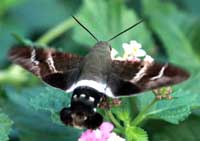 |
The body is dark brown with a wide white stripe across the abdomen.
The wings are dark brown. It is very similar to above species, but the
upperside of the hindwing has
pale patches along the costa and inner margin. rare fall stray |
Aellopos titan, September 12, 1979, Tom Middagh.
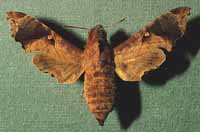
|
Enyo lugubris, the Mournful Sphinx,
TM stray:
The body and wings are dark brown. The forewing has a large black
patch covering most of the outer half of the wing. There is a pale
tan cell spot (dark inner pupil), and a fairly straight median line
to the inside of the cell spot.
|
Enyo lugubris Worthington, Nobles County, August 25, 2021, Tom Middaugh
 |
The abdomen has very distinct gray and black bands.
Adults nectar at dusk so you may see them in the garen at that time.
possibly only as a very rare fall stray
|
 |
During the night adults nectar at flowers, including bouncing bet
(Saponaria officinalis) and Asystasia gangetica beginning at dusk.
July and August are flight times in the southern states.
rare fall stray
|
Erinnyis obscura, October 2, 1979, Tom Middagh.
 |
Hemaris thysbe
TM, the Hummingbird Clearwing
This interesting day flier is not confirmed for Ramsey County.
They are widely distributed in the east from P.E.I. to Florida. |
See Hemaris comparisons.
Hemaris thysbe, June 19, 1976, Tom Middagh.
 |
Hemaris diffinis
WO, the Snowberry Clearwing or Bumblebee Moth
This moth is widely distributed and
might be present in Nobles County.
|
See Hemaris comparison
Philampelini tribe:
 |
Larvae get large and feed on grape vines and Virginia creeper.
|
Eumorpha achemon, August 1, 1976, Tom Middagh.
Macroglossini tribe:
 |
This day flier is widely distributed. If you have Virginia Creeper, you
probably have the Nessus Sphinx. Two bright, distinct, narrow yellow
bands are often visible on the abdomen.
|
Amphion floridensis, June 11, 1992, Tom Middagh.
 |
Darapsa myron
TM, the Virginia Creeper Sphinx or the
Grapevine Sphinx
If you have the foodplants indicated in the common names, you
probably have this species nearby. The lower wings are orange.
|
|
Darapsa myron, June 7, 1977, Tom Middagh.
 |
The moth's outer margin of the forewing is deeply scalloped.
The upperside is light brown with dark brown markings.
There is a small black and white spot near the tip.
Grape (Vitis), ampelopsis (Ampelopsis), and Virginia creeper
(Parthenocissus) all serve as larval hosts. |
Deidamia inscripta, May 21, 1977, Tom Middagh.
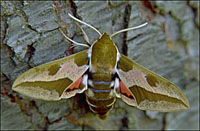 |
Hyles euphorbiae
TM, the Spurge Hawk Moth
The body is light brown with various white and dark brown
markings, while the wings have a conspicuous tan, brown, and pink or
red color pattern.
Tom Middagh confirms with adult in trap, July 20, 2007.
|
Hyles euphorbiae, July 20, 2007, Tom Middagh.
 |
Hyles gallii
TM, the Bedstraw Hawk Moth
or Gallium Sphinx
This species is not reported in Minnesota on USGS, but
Tom Middagh confirms its presence in Becker and Nobles counties.
Some years I see them on P.E.I., some years, I do not.
|
Hyles gallii, July 11, 1997, Tom Middagh.
 |
Hyles lineata
TM, the White-lined Sphinx
This species is recorded in Nobles County.
It is a strong migrator from the south,
and there are records from the east and from the west. |
Hyles lineata, June 2, 1975, Tom Middagh.
 |
This moth is much more common to the south. It is a strong migrant,
however, and may establish itself in Nobles County periodically.
|
Xylophanes tersa, August 3, 1975, Tom Middagh.
|
